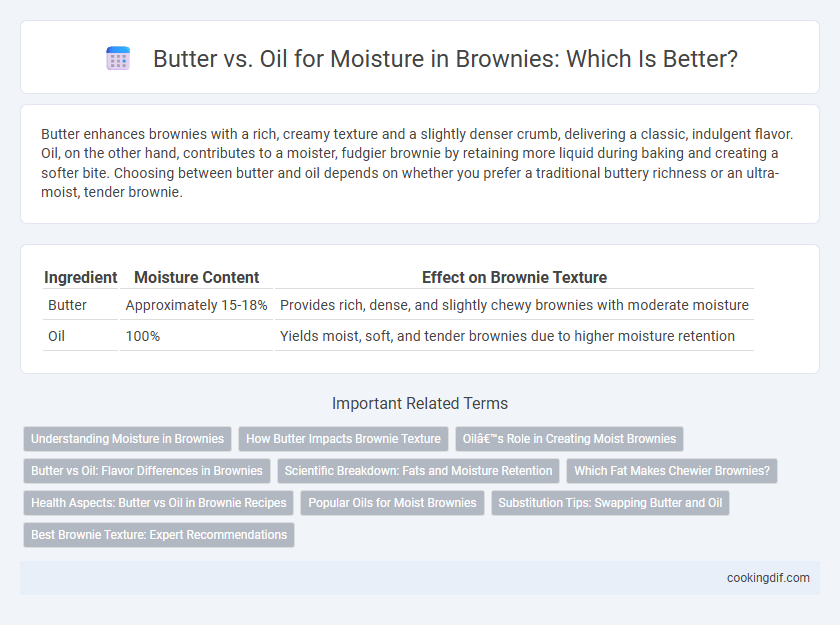Butter enhances brownies with a rich, creamy texture and a slightly denser crumb, delivering a classic, indulgent flavor. Oil, on the other hand, contributes to a moister, fudgier brownie by retaining more liquid during baking and creating a softer bite. Choosing between butter and oil depends on whether you prefer a traditional buttery richness or an ultra-moist, tender brownie.
Table of Comparison
| Ingredient | Moisture Content | Effect on Brownie Texture |
|---|---|---|
| Butter | Approximately 15-18% | Provides rich, dense, and slightly chewy brownies with moderate moisture |
| Oil | 100% | Yields moist, soft, and tender brownies due to higher moisture retention |
Understanding Moisture in Brownies
Butter in brownies contributes to a rich, creamy texture due to its water and milk solids content, which enhances moisture retention and flavor complexity. Oil, being 100% fat, creates a denser, fudgier brownie by coating flour proteins more thoroughly and trapping moisture more effectively. Understanding the different fat compositions explains why butter yields a tender crumb with subtle moisture, while oil produces a moister, chewier brownie texture.
How Butter Impacts Brownie Texture
Butter enhances brownie texture by adding richness and a tender crumb due to its solid fat content, which creates small air pockets during creaming. The milk solids in butter contribute to a deeper, more complex flavor and a slightly denser, fudgier consistency compared to oil. Unlike oil, butter helps achieve a delicate balance between moistness and structure, resulting in brownies with a melt-in-the-mouth quality.
Oil’s Role in Creating Moist Brownies
Oil plays a crucial role in creating moist brownies by coating flour proteins more effectively than butter, which limits gluten development and results in a tender texture. Unlike butter, which contains water that can evaporate during baking, oil remains liquid, retaining moisture throughout the cooking process. This sustained moisture content ensures brownies stay soft, dense, and fudgy, making oil the preferred fat for achieving consistently moist results.
Butter vs Oil: Flavor Differences in Brownies
Butter imparts a rich, creamy flavor and creates a denser texture in brownies, enhancing their overall taste profile with a slightly caramelized note. Oil produces a moister, softer crumb with a neutral flavor, allowing the chocolate or other ingredients to stand out more prominently. Choosing butter or oil directly affects the flavor intensity and texture, with butter delivering a classic, indulgent profile and oil offering a more subtle, tender bite.
Scientific Breakdown: Fats and Moisture Retention
Butter contains about 80% fat and 15-16% water, which helps retain moisture by releasing steam during baking, resulting in a tender and slightly dense brownie texture. Oil is 100% fat and retains moisture by coating flour proteins, preventing gluten formation and yielding a moist, fudgier brownie. The choice between butter and oil influences the brownie's crumb structure and mouthfeel due to their different water content and fat compositions.
Which Fat Makes Chewier Brownies?
Using oil in brownies typically results in a moister and denser texture, while butter contributes to a richer flavor with a slightly firmer structure. For chewier brownies, oil is often preferred because it retains more moisture and creates a soft, fudgy consistency by preventing the formation of gluten strands. However, using melted butter can enhance chewiness if combined with sugar to promote caramelization and a tender crumb.
Health Aspects: Butter vs Oil in Brownie Recipes
Butter contains saturated fats and vitamins A and E, which contribute to a rich flavor but can raise LDL cholesterol levels, while oil, especially vegetable or olive oil, offers healthier unsaturated fats that support heart health and enhance moisture retention in brownies. Using oil can result in a softer, more tender crumb due to its liquid state at room temperature, whereas butter provides a denser texture and distinct taste through its milk solids and water content. Choosing oil over butter in brownie recipes may improve cardiovascular health by reducing saturated fat intake without sacrificing moisture and texture quality.
Popular Oils for Moist Brownies
Using popular oils such as vegetable oil, canola oil, or coconut oil enhances the moisture and texture of brownies more effectively than butter, which can result in a denser crumb. Vegetable and canola oils offer a neutral flavor that preserves the classic rich taste, while coconut oil adds a subtle, complementary coconut aroma without sacrificing moistness. These oils prevent the brownies from drying out while maintaining a soft, fudgy bite that is highly sought after in moist brownie recipes.
Substitution Tips: Swapping Butter and Oil
Swapping butter with oil in brownie recipes changes the fat content and moisture retention, with oil generally producing denser, moister brownies due to its 100% fat makeup compared to butter's 80% fat and 20% water. For accurate substitution, use 20% less oil than the amount of butter called for, as oil's higher fat concentration impacts texture and mouthfeel. Opt for neutral oils like canola or vegetable oil to maintain the classic chocolate flavor while enhancing moistness in the final brownie.
Best Brownie Texture: Expert Recommendations
Butter delivers rich flavor and a tender crumb in brownies by creating a denser, fudgier texture favored by experts. Oil offers superior moisture retention, resulting in a softer, chewier brownie that stays fresh longer. Many professional bakers recommend combining butter and oil to balance flavor depth and moisture for the optimal brownie texture.
Butter vs oil for moisture Infographic

 cookingdif.com
cookingdif.com